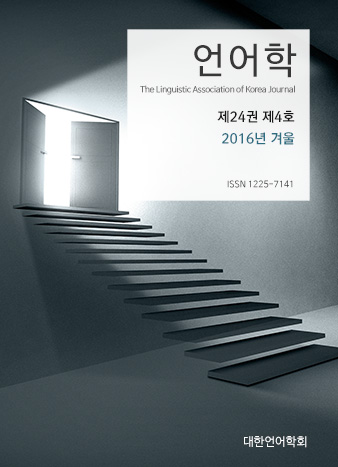대한언어학회 전자저널

-
An Alternative Approach to Realizations of the Medial [nt] Cluster in English
-
Boundary and pitch effects on the perception of Korean alveolar nasal
-
Corpus-Based English Grammar Instruction in a Korean College Context Korean College Context
-
A Study on the Relationship between Self-Efficacy Beliefs and Comprehension in English Reading
24권 4호 (2016년 12월)
- Corpus-Based English Grammar Instruction in a Korean College Context Korean College Context
-
Youn-Kyoung Lee
Pages : 39-60
Abstract
Keywords
# corpus-based language teaching # English grammar instruction in a Korean college context # contextualized lexicogrammar
References
- Aston, G. (2001). Learning with corpora: An overvoew. In G. Aston (Ed.), Learning with corpora (pp. 6-45). Huston, TX: Athelstan.
- Bennett, G. (2010). Using corpora in the language learning classroom: Corpus linguistics for teachers. Ann Arbor MI: University of Michigan Press.
- Betty S. A., & Satcy, A. H. (2006). Understanding and using English grammar. New York, NY: Pearson Longaman.
- Boulton, A. (2009). Data-driven learning: Reasonable fears and rational reassurance: New approaches for teaching and testing. Indian Journal of Applied Linguistics, 35(1), 81-106.
- Boulton, A. (2010). Data-driven learning: Taking the computer out of the equation. Language Learning, 60(3), 534-572.
- Carter, R., & McCathy, M. (2006). Cambridge grammar of English: A comprehensive guide-spoken and written English grammar use and usage. The Korea TESOL Journal, 9(1), 179-192.
- Celce-Murcia, M., & Larsen Freeman, D. (1999). The grammar book: An ESL/EFL teachers’ course (2nd ed.). Boston: Heinle & Heninle.
- Celce-Murcia, M., & Olshtain, E. (2000). Discourse and context in language teaching. Cambridge: Cambridge University Press.
- Clear, J. (2000). Do you believe in grammar? In L. Bernard & T. McEnery (Eds.), Rethinking language pedagogy from a corpus-based perspective (pp. 19-30). Bern: Peter Lang.
- Conrad, S. (2000). Will corpus linguistics revolutionize grammar teaching in the 21st century? TESOL Quarterly, 34(3), 548-559.
- Cotos, E. (2014). Enhancing writing pedagogy with learner corpus data. ReCALL, 26(2), 202-224.
- Curzan, A. (2009). Says who? Teaching and questioning the rules of grammar. PMLA, 124(4), 870-879.
- Ellis, N. C. (2005). At the interface: Dynamic interactions of explicit and implicit language knowledge. Studies in Second Language Learning, 27(2), 305-352.
- Ellis, R. (1995). Interpretation tasks for grammar teaching. TESOL Quarterly, 29(1), 87-105.
- Ellis, R. (2001). Investigating form-focused instruction. In R. Ellis (Ed.), Form-focused instruction and second language learning (pp. 1-46). Malden, MA: Blackwell.
- Ellis, R. (2002). Does form-focused instruction affect the acquisition of implicit knowledge? A review of the research. Studies in Second Language Acquisition, 24(2), 223-236.
- Francis, G. (1993). A corpus-driven approach to grammar: Principles, methods, and examples. In M. Baker, G. Francis & E. Tognini-Boneili (Eds.), Text and Technology (pp. 137-156). Amsterdam: Benjamins.
- Francis, G., Hunston, S., & Manning, E. (1998). Cobuild grammar patterns 2: Nouns. London: Harper Collins.
- Hinkel, E., & Fotos, S. (Eds.), (2002). New perspectives on grammar teaching in second language classrooms. Mahwah, NJ: Erlbaum.
- Hughes, R., & McCarthy, M. (1998). From sentence to discourse: Discourse grammar and English language teaching. TESOL Quarterly, 32(2), 263-287.
- Hunston, S. (2002). Corpora in applied linguistics. Cambridge: Cambridge University Press.
- Hunston, S., & Francis, G. (1998). Verbs observed: A corpus-driven pedagogical grammar. Applied Linguistics, 19(1), 45-72.
- Hunston, S., & Francis, G. (2000). Pattern grammar: A corpus-driven approach to the lexical grammar of English. Amsterdam: Benjamins.
- Kolln, M. J., & Gray, L. S. (2009). Rhetorical grammar: Grammatical effects, rhetorical effects. New York, NY: Pearson Longman.
- Larsen-Freeman, D. (2002). The grammar of choice. In E. Hinkel & S. Fotos (Eds.), New perspectives on pedagogical grammar (pp. 103-118). Mahwah, NJ: Erlbaum.
- Larsen-Freeman, D. (2003). Teaching language: From grammar to grammaring. Boston: Heinle & Heinle.
- Larsen-Freeman, D., & Cameron, L. (2008). Complex system and applied linguistics. Oxford: OUP.
- Nam, D. (2010). The effects of corpus-based langauge instruction on productive vocabulary knowledge. Multimedia-Assisted Language Learning, 13(2), 155-176.
- O’Keeffe, A., & Farr, F. (2003). Using language corpora in initial teacher education: Pedagogical issues and practical applications. TESOL Quarterly, 37(3), 389-418.
- O’Keeffe,A., McCarthy, M., & Carter, R. (2007). From corpus to classroom: Language use and language teaching. Cambridge: Cambridge University Press.
- Park, S., & Yoon, H. (2009). A study on the effect of corpus-based vocabulary learning. Studies in English Language and Literature, 51(3), 145-165.
- Philp, J. (2003). Constraints on “noticing the gap”: Non-native speakers’ noticing of recasts in NS-NNS interaction. Studies in Second Language Acquisition, 25(1), 99-126.
- Pharr, D., & Buscemi, S. V. (2005). Writing today: Context and options for the real world. Boston: McGraw-Hill.
- Schmitt, N. (2004). Formulaic sequences. Amsterdam: Benjamins.
- Schmitt, N. (2005). Current research perspectives and grammar teaching. Presented at the 39th TESOL Convention, San Antonio, TX.
- Sealey, A., & Thompson, P. (2004). ‘What do you call the dull words?’ Primary school children uing corpus-based approaches to learn about language. English in Education, 38(1), 80-91.
- Sealey, A., & Thompson, P. (2007). Through children’s eyes?: Corpus evidence of the features of children’s literature. International Journal of Corpus Linguistics, 12(1), 1-23.
- Sinclair, J. M. (1991). Corpus, concordance, and collocation. Oxford: Oxford University Press.
- Sinclair, J. M. (2004). How to use corpora in language teaching. Amsterdam: Benjamins.
- Youn, H., & Hirvela, A. (2004). ESL student attitudes toward corpus use in L2 writing. Journal of Second Language Writing, 13(4), 257-283.
- Yoon, H. (2008). More than a linguistic reference: The influence of corpus technology on L2 academic writing. Language Learning & Technology, 12(2), 31-48.